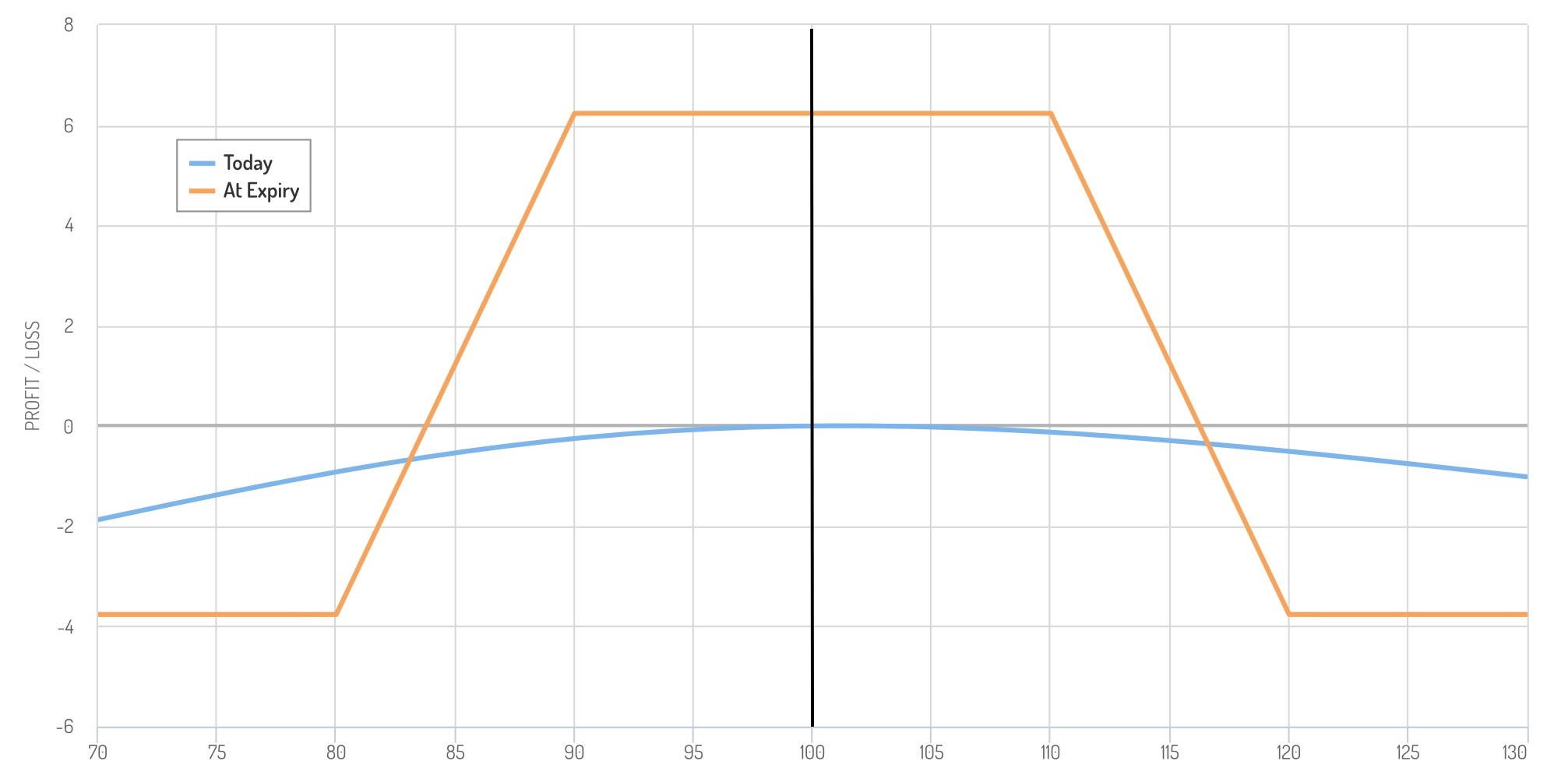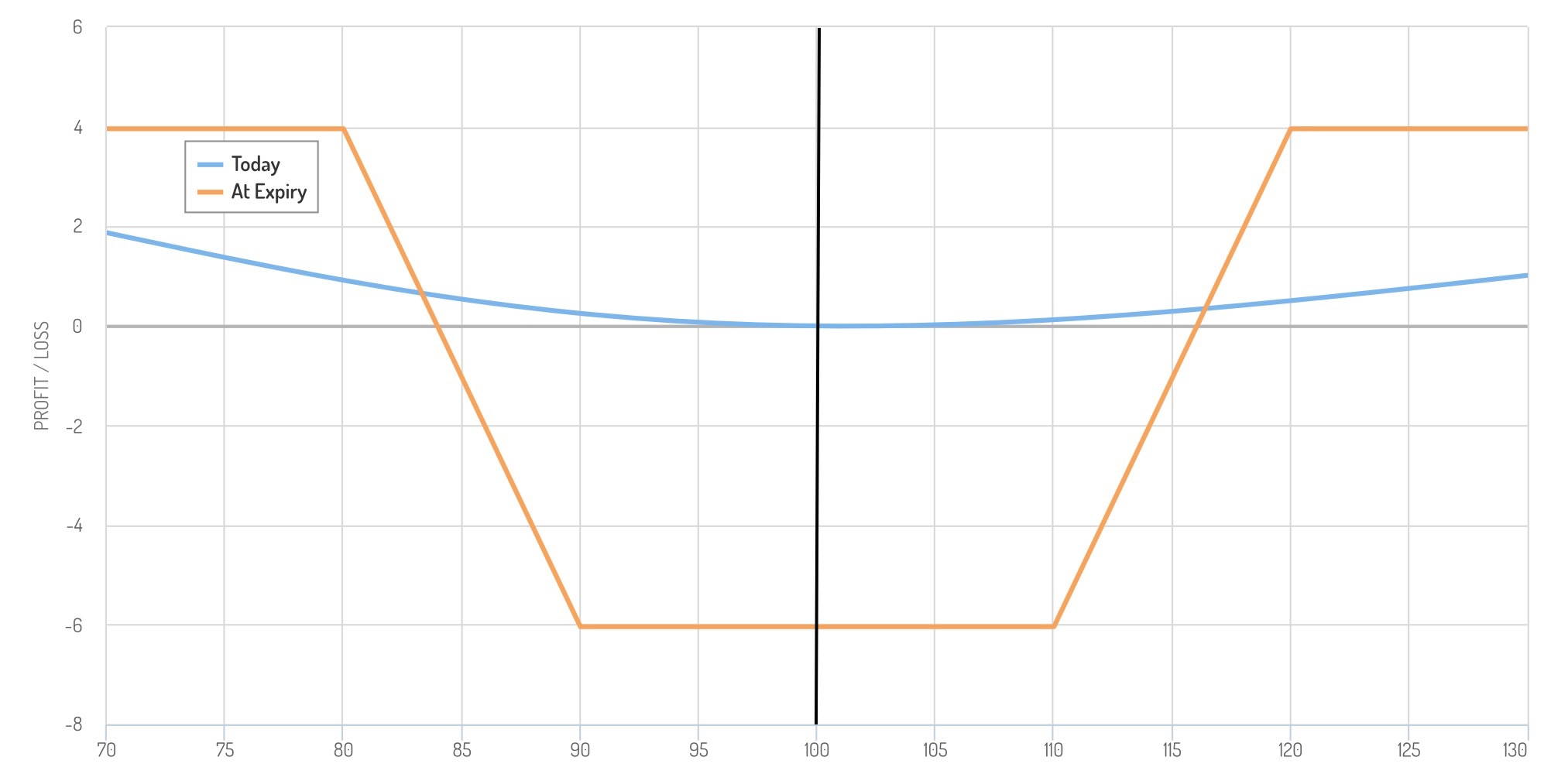Iron Condors are defined risk strategies with two break-even-points. They are one of the most commonly used option strategies.
Video Breakdown:
Short Iron Condor Strategy

Market Assumption:
When trading Short Iron Condors you should have a neutral/range bound market assumption. This means you hope for relatively small or no move at all in the underlying. Short Iron Condors can be very slim (just a few strikes apart) or very wide (far apart strikes) depending on your assumption. Many people including me use Short Iron Condors with two high probability strikes as a high probability strategy.
Setup:
- Buy 1 OTM Put
- Sell 1 OTM Put (higher strike)
- Sell 1 OTM Call
- Buy 1 OTM Call (higher strike)
This should result in a credit (You get paid to open).
Profit and Loss:
As you can see on the payoff-diagram a Short Iron Condor isn’t just a defined risk trade, but also a defined profit trade. The maximum profit is achieved when the underlying price is somewhere between the two short strikes. The maximum loss occurs when the price is anywhere outside of the two long strikes. It doesn’t matter if the price is $10 or $100 outside of the profitable range because the two long options on both sides act as a hedge. The maximum loss is higher than the maximum profit.
Maximum Profit: Premium received – Commissions
Ex. $20 Premium – $3 Commission = $17 (max profit)
Maximum Loss: Width of Call Strikes * 100 – Premium Received + Commissions Paid
Ex. (Call Strikes: 50 and 52) => $2 Width * 100 – $20 Premium + $3 Commissions = $183 (max loss)
(a normal option contract controls 100 shares, therefore *100)
Implied Volatility and Time Decay:
A Short Iron Condor profits from a drop in Implied Volatility (IV), because the options sold then lose value. Therefore, it is best to use this strategy in times of high IV (IV rank over 50).
Time Decay also works in favor of this strategy. The more time goes by the more the sold options lose in their extrinsic value. The time decay for each day increases the closer you get to expiration.
Long Iron Condor Strategy/Reverse Iron Condor

Market Assumption:
When trading a Long Iron Condor (aka. Reverse Iron Condor) you would expect a relatively big move in a short period of time, but you don’t quite know in which direction this move will be. The bigger a move you expect, the further the long strikes have to be apart. This strategy isn’t used that often but can be quite profitable when used correctly. But keep in mind it is much harder to predict an unusual big move than predicting something to stay range-bound.
Setup:
- Sell 1 OTM Put
- Buy 1 OTM Put (higher strike)
- Buy 1 OTM Call
- Sell 1 OTM Call (higher strike)
This should result in a Debit (You pay to open)
Profit and Loss:
This also is a defined risk/profit strategy. Maximum profit is achieved when the price of the underlying asset moves further than one of the short positions. It doesn’t matter if it’s above the highest strike or below the lowest. Maximum loss, on the other hand, occurs when the price stays at the same position or just moves a little (stays between the two long options). For long Iron Condors, the max profit exceeds the max loss.
Maximum Profit: Width of Call Strikes * 100 – Premium Paid + Commissions Paid
Ex. (Call Strikes: 50 and 52) => $2 Width * 100 – $20 Premium + $3 Commissions = $183 (max profit)
Maximum Loss: Premium paid + Commissions
Ex. $17 paid to open + $3 commission = $20 (max loss)
Implied Volatility and Time Decay:
Just like in the other categories a Long Iron Condor also here is just the opposite of a Short Iron Condor. It profits from a rise in IV, therefore should be bought in times with relatively low IV (IV rank under 50).
Time decay works against a Long Iron Condor because the Long options lose a bit of value every day. They lose more and more value the closer you get to expiration.
Trader’s Note:
Iron Condors are a very useful, popular and profitable option strategy. Together with Credit Spreads, Short Iron Condors make up the easiest and best strategies for high probability trading. Short Iron Condors are a range bound strategy, profiting from no or small moves in the underlying price. If you set your strikes out far enough, these spreads will have a high chance of being profitable. The further you go OTM with your strikes, the higher your probability of success will become. But your max loss will rise and your max profit will decrease. When used correctly, Iron Condors can be very profitable and that is the reason why I use them and do recommend them in my training as well (check out my training here).
A Long Iron Condor, on the other hand, is more of a directional strategy. Even though it is not bullish or bearish, it needs the price to move to be profitable. You don’t care in which direction as long as the price moves far enough. Long Iron Condors are best used in times where a big move may stand ahead, but it is unclear in which direction this move will be. This could be the case for special events like earnings, elections, referendums, big market announcements… The further you set your strikes away from the underlying trading price, the lower your probability of profit will become, but your profit potential will rise.
How To Set Up Iron Condors In A Broker Platform:
You Can Read More About Tastyworks By Reading My Tastyworks Review here!

Wow!! I have traded stocks before and have never understood this. That was explained very well. I will be watching your sight in the near future to understand it better. Thanks for sharing this knowledge
Hey Kim,
So so glad that you are learning more and enjoying my site.
So I see the iron condor is a strategy that involves the combination of two vertical spreads. So in the case of a short iron condor, rather than saying that you believe a stock will move in a direction, are we saying that we think the stock will stay within certain upper and lower limits? And visa versa for the long? Rather than stay in a range, we want it to go up or down. Either one would be fine, right? What kind of probabilities are you shooting for when you apply an iron condor?
Thank you for your help!
Hey Neil,
That is correct. The short iron condor is a range bound strategy, whereas the long iron condor is a price indifferent strategy (you don’t care where the price moves, as long as it moves). I only trade short iron condors and usually aim at a probability of ITM of 70%.
I like it! Thanks for being responsive to comments as well. So a 70% probability of being in the money. How many days until expiration do you usually like to sell at? Do you stick with monthly or do you use weeklies?
Hey once again,
I normally stick to monthly contracts and enter iron condors around 30 days before expiration. But I actually trade much more credit spreads than iron condors. If you want to learn my entire option strategy (option premium selling), you could also check out my intermediate course here. In there I thourougly explain how I make money with options.
If you have any further questions, I would be happy to answer them.
Hi Louis,
Glad found your website here to learn option. Do u think to trade Iron Condor we should find 30% Prob ITM instead of 70% Prob ITM as taught by Sky View Trading?. Please help me to explain this.Thanks.
Hi Harry,
Thanks for your question. I recommend focusing on the probability of profit (POP) instead of the probability of ITM. The probability of profit tells you what the probability of actually making money is, whereas the probability of ITM doesn’t. Your overall POP on a short Iron condor should ideally be over 50%.
I recently wrote an entire article about the different options trading probabilities. So make sure to check that out for a more detailed explanation of all the different probabilities.
Hopefully, this helps. Please let me know if you have any other (follow-up) questions or comments).
Hi Lois,
Glad I found your website to lear Option. hmmm do you think we should find 30% Prob ITM instead of 70% Prob ITM taught by Sky View Trading. Please help me explain about this.Thanks
Hi Louis!
I’ve been going through your Options Trading Education material and just wanted to say thank you! Your information has been invaluable and it’s so kind of you to share all of this for free. Your hard work is greatly appreciated! My sincerest thank you.
Thanks for the feedback! I appreciate the kind words.